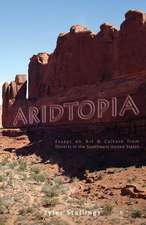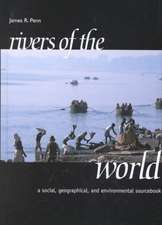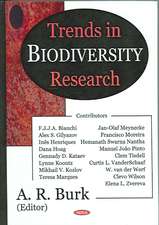Nonlinear Physics of Ecosystems
Autor Ehud Meronen Limba Engleză Hardback – 15 apr 2015
The first part of the book gives an overview of pattern formation and spatial ecology, showing how these disparate research fields are strongly related to one another. The next part presents an advanced account of pattern formation theory. The final part describes applications of pattern formation theory to ecological problems, including self-organized vegetation patchiness, desertification, and biodiversity in changing environments.
Focusing on the emerging interface between spatial ecology and pattern formation, this book shows how pattern formation methods address a variety of ecological problems using water-limited ecosystems as a case study. Readers with basic knowledge of linear algebra and ordinary differential equations will develop a general understanding of pattern formation theory while more advanced readers who are familiar with partial differential equations will appreciate the descriptions of analytical tools used to study pattern formation and dynamics.
| Toate formatele și edițiile | Preț | Express |
|---|---|---|
| Paperback (1) | 374.90 lei 6-8 săpt. | |
| CRC Press – 15 oct 2019 | 374.90 lei 6-8 săpt. | |
| Hardback (1) | 1282.04 lei 6-8 săpt. | |
| CRC Press – 15 apr 2015 | 1282.04 lei 6-8 săpt. |
Preț: 1282.04 lei
Preț vechi: 1563.46 lei
-18% Nou
Puncte Express: 1923
Preț estimativ în valută:
245.32€ • 256.66$ • 203.79£
245.32€ • 256.66$ • 203.79£
Carte tipărită la comandă
Livrare economică 02-16 aprilie
Preluare comenzi: 021 569.72.76
Specificații
ISBN-13: 9781439826317
ISBN-10: 1439826315
Pagini: 358
Ilustrații: 146 black & white illustrations, 2 black & white tables
Dimensiuni: 156 x 234 x 23 mm
Greutate: 0.73 kg
Ediția:1
Editura: CRC Press
Colecția CRC Press
ISBN-10: 1439826315
Pagini: 358
Ilustrații: 146 black & white illustrations, 2 black & white tables
Dimensiuni: 156 x 234 x 23 mm
Greutate: 0.73 kg
Ediția:1
Editura: CRC Press
Colecția CRC Press
Public țintă
Academic and Professional Practice & DevelopmentCuprins
Introduction. OVERVIEW: Spatial Self-Organization. Spatial Ecology. Modeling Ecosystems. PATTERN FORMATION THEORY: Pattern Formation Analysis: Basic Methods. Pattern Formation Analysis: Advanced Methods. Basic Mechanisms of Pattern Formation. External Modulations of Pattern Forming Systems. APPLICATIONS TO ECOLOGY: Modeling Water-Limited Vegetation. Vegetation Pattern Formation. Regime Shifts and Desertification. Species Coexistence and Diversity in Plant Communities. Bibliography. Index.
Notă biografică
Ehud Meron is a professor of physics in the Blaustein Institutes for Desert Research and the Physics Department at Ben-Gurion University of the Negev. His research interests include nonlinear dynamics and pattern formation theory with applications to fluid dynamics and chemical reactions, modeling complex systems, and spatial ecology with a focus on desertification and biodiversity dynamics. Professor Meron’s recent work has involved collaborating with ecologists in an effort to assimilate the concepts of pattern-formation theory into ecological research.
Recenzii
"I was greatly impressed by the variety of topics covered and by the depth in which they are discussed. ... The author's introduction to each topic is clear, and the book's overall organization makes it easily readable. ... I would recommend it to graduate students who want to conduct research in mathematical ecology or physics applied to spatial ecology problems. ... I also warmly recommend the book for nonlinear physicists, applied mathematicians, and theoretical ecologists working on cutting-edge environmental interdisciplinary problems."
--Physics Today, October 2015
"The approach taken by the author is simultaneously rigorous and relevant. ... This book easily reaches the objectives set for it by its author and is thus strongly recommended to its target audience."
--Contemporary Physics, 2015
"a masterful treatment of the topic of vegetation self-organization that is more than simply a synthesis of previous work-- it pushes the field ahead.... This book is essential reading for all ecologists, physicists, and mathematicians, both students and practitioners alike, interested in the topic of ecological pattern formation or pattern formation in general."
-- SIAM Review (Aug 2016)
"... a much-needed contemporary perspective ... unfolds the origin of coherency of spatial patterning in one of the most significant biological systems the human population depends on--arid and semiarid climates."
--Gabriel G. Katul, Professor of Hydrology and Micrometeorology, Duke University
"The science of pattern formation reaches dazzling new heights as physicist Ehud Meron explains to us the nonlinear spatial dynamics of complex ecological systems. This is the definitive textbook on the subject as written by one of the key pioneers in the field. No other book comes close to showing the power of modern theoretical physics for solving real in-depth problems in ecology. Step by step, carefully formulated model equations are developed for dealing with advanced ecological topics, such as water-limited desert vegetation systems, soil-water diffusion, root-augmentation, plants as ecosystem engineers, reversing desertification, and species coexistence and diversity. ... a huge achievement."
--Professor Lewi Stone, Biomathematics Unit, Tel Aviv University
"An important and timely book that shows the generality and power of the pattern formation paradigm and its wide applicability to diverse natural systems."
--Stephen Morris, J. Tuzo Wilson Professor of Geophysics, University of Toronto
"An authoritative account of the state of the art in ecological patterning."
--Jonathan A. Sherratt, Professor of Mathematics, Heriot-Watt University
"... a major and unique contribution to the mathematics and physics of ecosystems. ... It should become a major reference. I am very pleased to endorse this book."
--Roger Temam, Distinguished Professor, Institute for Scientific Computing and Applied Mathematics, Indiana University
"... an excellent and important read on the rapidly emerging field of integrating pattern formation theory with spatial ecology, with real-world applications and implications."
--Prof. dr. ir. M. Rietkerk, Utrecht University
"... addresses a critical need and should quickly become a favorite of both beginning students and senior practitioners ... ."
--Herbert Levine, Hasselmann Professor of Bioengineering and Director of the Center for Theoretical Biological Physics, Rice University
--Physics Today, October 2015
"The approach taken by the author is simultaneously rigorous and relevant. ... This book easily reaches the objectives set for it by its author and is thus strongly recommended to its target audience."
--Contemporary Physics, 2015
"a masterful treatment of the topic of vegetation self-organization that is more than simply a synthesis of previous work-- it pushes the field ahead.... This book is essential reading for all ecologists, physicists, and mathematicians, both students and practitioners alike, interested in the topic of ecological pattern formation or pattern formation in general."
-- SIAM Review (Aug 2016)
"... a much-needed contemporary perspective ... unfolds the origin of coherency of spatial patterning in one of the most significant biological systems the human population depends on--arid and semiarid climates."
--Gabriel G. Katul, Professor of Hydrology and Micrometeorology, Duke University
"The science of pattern formation reaches dazzling new heights as physicist Ehud Meron explains to us the nonlinear spatial dynamics of complex ecological systems. This is the definitive textbook on the subject as written by one of the key pioneers in the field. No other book comes close to showing the power of modern theoretical physics for solving real in-depth problems in ecology. Step by step, carefully formulated model equations are developed for dealing with advanced ecological topics, such as water-limited desert vegetation systems, soil-water diffusion, root-augmentation, plants as ecosystem engineers, reversing desertification, and species coexistence and diversity. ... a huge achievement."
--Professor Lewi Stone, Biomathematics Unit, Tel Aviv University
"An important and timely book that shows the generality and power of the pattern formation paradigm and its wide applicability to diverse natural systems."
--Stephen Morris, J. Tuzo Wilson Professor of Geophysics, University of Toronto
"An authoritative account of the state of the art in ecological patterning."
--Jonathan A. Sherratt, Professor of Mathematics, Heriot-Watt University
"... a major and unique contribution to the mathematics and physics of ecosystems. ... It should become a major reference. I am very pleased to endorse this book."
--Roger Temam, Distinguished Professor, Institute for Scientific Computing and Applied Mathematics, Indiana University
"... an excellent and important read on the rapidly emerging field of integrating pattern formation theory with spatial ecology, with real-world applications and implications."
--Prof. dr. ir. M. Rietkerk, Utrecht University
"... addresses a critical need and should quickly become a favorite of both beginning students and senior practitioners ... ."
--Herbert Levine, Hasselmann Professor of Bioengineering and Director of the Center for Theoretical Biological Physics, Rice University
Descriere
Using problems from spatial ecology, this book shows how pattern formation theory can be applied to ecological research. Written in language understandable to most physicists and ecologists, it reveals the mechanisms of pattern formation and pattern dynamics. The book explores the implications of these mechanisms in important ecological problems, including self-organized vegetation patchiness, desertification, and biodiversity in changing environments. It also discusses recent developments, such as pattern-forming systems subjected to external periodic forcing, not covered in similar books.

















